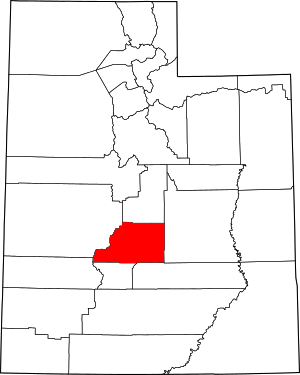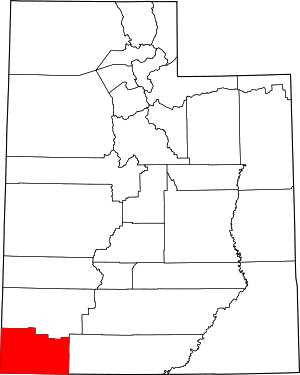Paiute Indian Tribe of Utah
The Paiute Indian Tribe of Utah is a federally recognized tribe of Southern Paiute and Ute Indians in southwestern Utah.[1]
| Total population | |
|---|---|
| 928 | |
| Regions with significant populations | |
| Languages | |
| English, Southern Paiute | |
| Religion | |
| Christianity, Native American Church, traditional tribal religion, previously Ghost Dance | |
| Related ethnic groups | |
| other Southern Paiute tribes, Chemehuevi, and Ute |
Reservation
The Paiute Indian Tribe of Utah (PITU) has a reservation composed of ten separate parcels of land, located in four counties in southwestern Utah.[2]
History
Two Ute bands were absorbed into the Paiute Indian Tribe of Utah. The Pahvant band originally lived in the deserts near Sevier Lake, west of the Wasatch Mountains of western Utah. Many Pahvants were removed by the US government to the Uintah Reservation, but some joined the Kanosh, Koosharem, and other settlements in Utah. The second band was the Moanunts, who traditionally lived near Sevier River and Otter Creek, south of Salina, Utah.[3]
Termination and Restoration
During the period from the 1940s - 1960s, in which the Indian termination policy was enforced, The Paiute Indian Tribe was targeted for termination. On 1 September 1954 the US Congress passed Termination of Federal Supervision over the Paiute Indians of Utah U.S. Code, Title 25, Sections 741-60. The legislation at §742 specified that the included bands were the Shivwits, Kanosh, Koosharem, and Indian Peaks Bands of the Paiute Indian Tribe (omitting the Cedar Band).[4] As with other termination agreements, the Act provided for termination of federal trusts and distribution of tribal lands to individuals or a tribally organized entity. It had provisions to preserve the tribal water rights and a special education program to assist tribal members in learning how to earn a living, conduct affairs, and assume their responsibilities as citizens.[5] The Bureau of Land management terminated tribal trusts on 1 March 1957[6] as did the Indian Health Service.[7]
On 3 April 1980, Congress passed the Paiute Indian Tribe of Utah Restoration Act, Public Law 96-227 94 Stat. 317, which restored the federal trust relationship of the Shivwits, Kanosh, Koosharem, and Indian Peaks Bands of the Paiute Indian Tribe and restored and reaffirmed that the Cedar Band was part of the Tribe. The law acknowledged that the Kanosh, Koosharem, and Indian Peaks Bands had lost their lands as a result of termination and that the Cedar Band had never had any. It proposed to develop within two years of enactment a plan to secure reservation land for the tribe not to exceed 15,000 acres.[8] The Bureau of Land management reinstituted the federal trust on 43,576.99 acres concurrent with the enactment of the statute.[6]
Today
The Paiute Indian Tribe of Utah's tribal headquarters is located in Cedar City, Utah. As of 2006, 840 people were enrolled in the tribe.[2] The Utah Paiute's tribal chairperson is Tamra "Tami" Borchardt-Slayton and their vice-chairperson is Patrick Charles.
The Paiute Tribe made national news when former Chairperson Gari Pikyavit Lafferty was impeached in 2015,[9] After accepting gifts from Washington Redskins owner Dan Snyder which were ostensibly made in an attempt to induce the tribe to publicly endorse the team's controversial name, the Tribal Council charged Gari Pikyavit Lafferty, then tribal chairperson, on March 26, 2015 with violating the tribe's Ethics Ordinance, Constitution and Standards of Conduct as well as ignoring the express directives of the Tribal Council, interfering with internal band matters and misusing her title.[10]
The Paiute Indian Tribe of Utah operates its own programs for health, behavioral care, housing, education, economic development.[2] Proposed economic development enterprises include geothermal plants, agricultural, convenience stores, gift stores, restaurants, hotels, and a cultural centers.[11]
Bands
The tribe is made up of five constituent bands, who have been independent communities for centuries.
Cedar Band of Paiutes
The "Cedar Band of Paiute Indians" or Suh’dutsing ("Cedar People") received federal recognition on April 3, 1980 under the Paiute Indian Tribe of Utah Restoration Act. Their band headquarters is located in Cedar City, Utah.[12] Their band chairperson is Travis N. Parashonts.[13]
Kanosh Band of Paiutes
The "Kanosh Band of Paiute Indians" or Kawnaw’os ("willow [water] jug") first received federal recognition on February 11, 1929. Their band headquarters is located in Cedar City, Utah. An additional tribal office is located in Kanosh, Utah, near their traditional ancestral home.[14] Their Band Chairperson is Corrina Bow.[13]
Koosharem Band of Paiutes
The "Koosharem Band of Paiute Indians" or Paw goosawd’uhmpuhtseng ("Water Clover People") first received federal recognition on March 3, 1928. Their band headquarters is located in Richfield, Utah.[15] Their Band Chairperson is LaTosha Mayo.[13]
Indian Peaks Band of Paiutes
The "Indian Peaks Band of Paiute Indians" or Kwee’choovunt ("Peak People") first received federal recognition on August 2, 1915 and have lands in Beaver County, Utah. Their band headquarters is located in Cedar City, Utah.[16] Their Band Chairperson is Jeanine Borchardt.[13]
Shivwits Band of Paiutes
The first reservation of the "Shivwits Band of Paiutes" or See’veetseng ("Whitish Earth People") was established in 1891. They received federal recognition on March 3, 1891. They have lands in Washington County, Utah. Their band headquarters is located in Ivins, Utah.[17] Their Band Chairperson is Patrick Charles.[13]
Notes
- Pritzker, 233
- "Home." Paiute Indian Tribe of Utah. (retrieved 12 Dec 2009)
- D'Azevedo
- "25 U.S. Code § 742 - Definitions".
- "25 U.S. Code Chapter 14, Subchapter XXXII - PAIUTE INDIANS OF UTAH: TERMINATION OF FEDERAL SUPERVISION".
- "Indian Issues: BLM's Program for Issuing Individual Indian Allotments on Public Lands Is No Longer Viable".
- "Archived copy". Archived from the original on 2012-07-23. Retrieved 2014-12-27.CS1 maint: archived copy as title (link)
- http://www.gpo.gov/fdsys/pkg/STATUTE-94/pdf/STATUTE-94-Pg317.pdf
- "Tribal Government: 2009 Tribal Chairperson Election Results. Paiute Indian Tribe of Utah. 11 March 2009 (retrieved 12 Dec 2009)
- McKenna, Dave. "Paiute Tribal Leader Faces Impeachment For Taking Redskins Gifts". Deadspin. Retrieved 2 April 2015.
- "Economic Development." Paiute Indian Tribe of Utah. (retrieved 12 Dec 2009)
- "Cedar Band of Paiutes." Paiute Indian Tribe of Utah. 11 March 2009 (retrieved 12 Dec 2009)
- "Tribal Government: 2009 Band Chairperson Election Results.
- "Kanosh Band of Paiutes." Paiute Indian Tribe of Utah. 11 March 2009 (retrieved 12 Dec 2009)
- "Koosharem Band of Paiutes." Paiute Indian Tribe of Utah. 11 March 2009 (retrieved 12 Dec 2009)
- "Indian Peaks Band of Paiutes." Paiute Indian Tribe of Utah. 11 March 2009 (retrieved 12 Dec 2009)
- "Shivwits Band of Paiutes." Paiute Indian Tribe of Utah. 11 March 2009 (retrieved 12 Dec 2009)
References
- D'Azevedo, Warren L., Volume Editor. Handbook of North American Indians, Volume 11: Great Basin'. Washington, DC: Smithsonian Institution, 1986. ISBN 978-0-16-004581-3.
- Pritzker, Barry M. A Native American Encyclopedia: History, Culture, and Peoples. Oxford: Oxford University Press, 2000. ISBN 978-0-19-513877-1.
External links
- Paiute Indian Tribe of Utah, official website



